2020 Hyundai Ioniq Hybrid trailer
[x] Cancel search: trailerPage 316 of 613
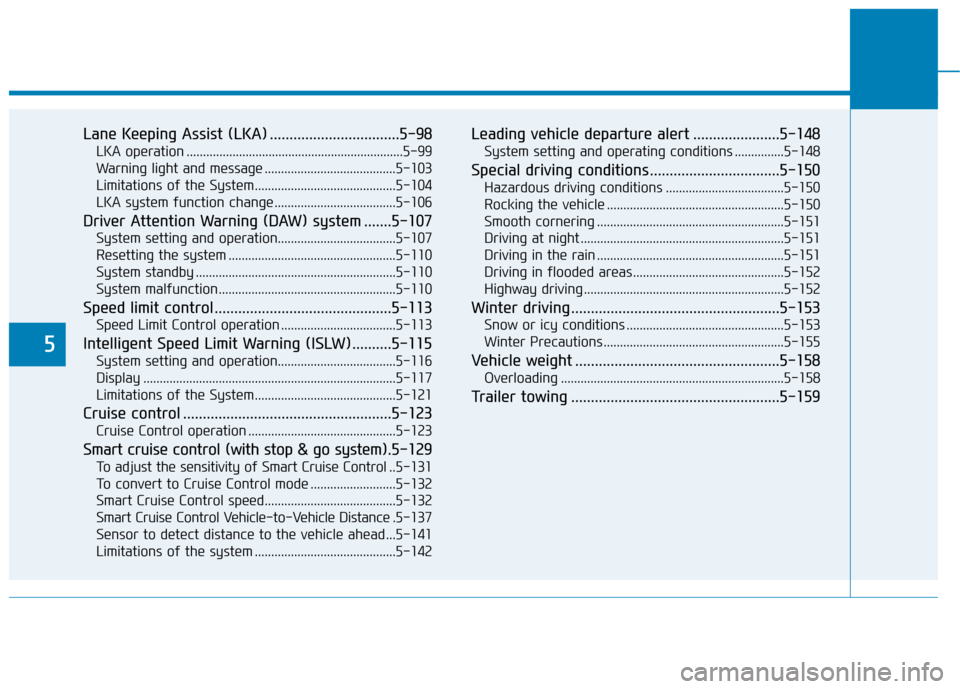
5
Lane Keeping Assist (LKA) .................................5-98
LKA operation ..................................................................5-99
Warning light and message ........................................5-103
Limitations of the System...........................................5-104
LKA system function change .....................................5-106
Driver Attention Warning (DAW) system .......5-107
System setting and operation....................................5-107
Resetting the system ...................................................5-110
System standby .............................................................5-110
System malfunction......................................................5-110
Speed limit control .............................................5-113
Speed Limit Control operation ...................................5-113
Intelligent Speed Limit Warning (ISLW) ..........5-115
System setting and operation....................................5-116
Display .............................................................................5-117
Limitations of the System...........................................5-121
Cruise control .....................................................5-123
Cruise Control operation .............................................5-123
Smart cruise control (with stop & go system).5-129
To adjust the sensitivity of Smart Cruise Control ..5-131
To convert to Cruise Control mode ..........................5-132
Smart Cruise Control speed........................................5-132
Smart Cruise Control Vehicle-to-Vehicle Distance .5-137
Sensor to detect distance to the vehicle ahead ...5-141
Limitations of the system ...........................................5-142
Leading vehicle departure alert ......................5-148
System setting and operating conditions ...............5-148
Special driving conditions .................................5-150
Hazardous driving conditions ....................................5-150
Rocking the vehicle ......................................................5-150
Smooth cornering .........................................................5-151
Driving at night ..............................................................5-151
Driving in the rain .........................................................5-151
Driving in flooded areas..............................................5-152
Highway driving .............................................................5-152
Winter driving .....................................................5-153
Snow or icy conditions ................................................5-153
Winter Precautions .......................................................5-155
Vehicle weight ....................................................5-158
Overloading ....................................................................5-158
Trailer towing .....................................................5-159
Page 377 of 613
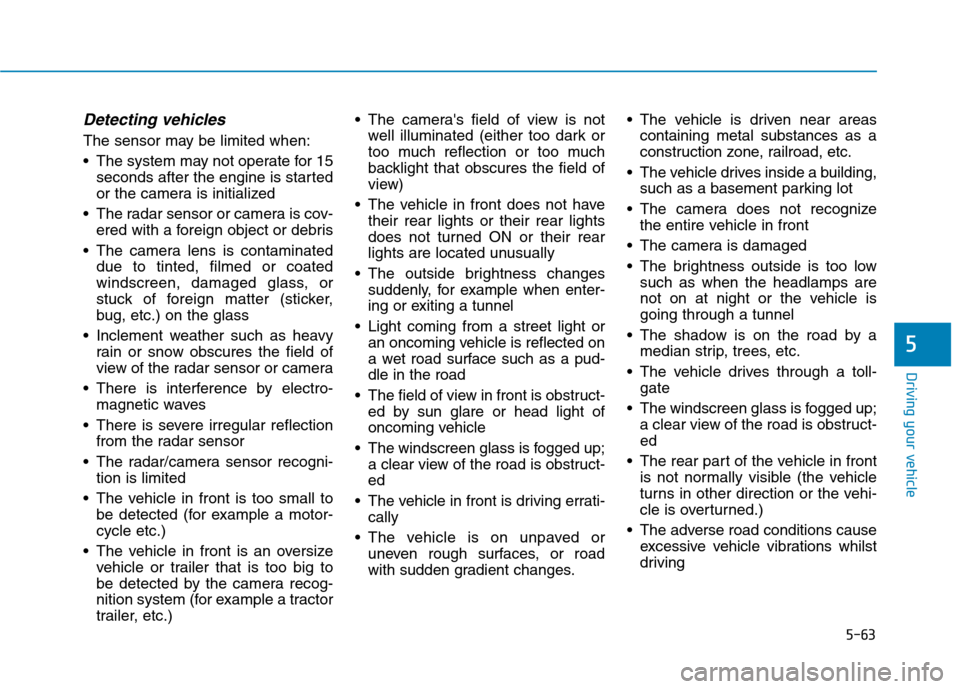
5-63
Driving your vehicle
5
Detecting vehicles
The sensor may be limited when:
The system may not operate for 15
seconds after the engine is started
or the camera is initialized
The radar sensor or camera is cov-
ered with a foreign object or debris
The camera lens is contaminated
due to tinted, filmed or coated
windscreen, damaged glass, or
stuck of foreign matter (sticker,
bug, etc.) on the glass
Inclement weather such as heavy
rain or snow obscures the field of
view of the radar sensor or camera
There is interference by electro-
magnetic waves
There is severe irregular reflection
from the radar sensor
The radar/camera sensor recogni-
tion is limited
The vehicle in front is too small to
be detected (for example a motor-
cycle etc.)
The vehicle in front is an oversize
vehicle or trailer that is too big to
be detected by the camera recog-
nition system (for example a tractor
trailer, etc.) The camera's field of view is not
well illuminated (either too dark or
too much reflection or too much
backlight that obscures the field of
view)
The vehicle in front does not have
their rear lights or their rear lights
does not turned ON or their rear
lights are located unusually
The outside brightness changes
suddenly, for example when enter-
ing or exiting a tunnel
Light coming from a street light or
an oncoming vehicle is reflected on
a wet road surface such as a pud-
dle in the road
The field of view in front is obstruct-
ed by sun glare or head light of
oncoming vehicle
The windscreen glass is fogged up;
a clear view of the road is obstruct-
ed
The vehicle in front is driving errati-
cally
The vehicle is on unpaved or
uneven rough surfaces, or road
with sudden gradient changes. The vehicle is driven near areas
containing metal substances as a
construction zone, railroad, etc.
The vehicle drives inside a building,
such as a basement parking lot
The camera does not recognize
the entire vehicle in front
The camera is damaged
The brightness outside is too low
such as when the headlamps are
not on at night or the vehicle is
going through a tunnel
The shadow is on the road by a
median strip, trees, etc.
The vehicle drives through a toll-
gate
The windscreenglass is fogged up;
a clear view of the road is obstruct-
ed
The rear part of the vehicle in front
is not normally visible (the vehicle
turns in other direction or the vehi-
cle is overturned.)
The adverse road conditions cause
excessive vehicle vibrations whilst
driving
Page 389 of 613
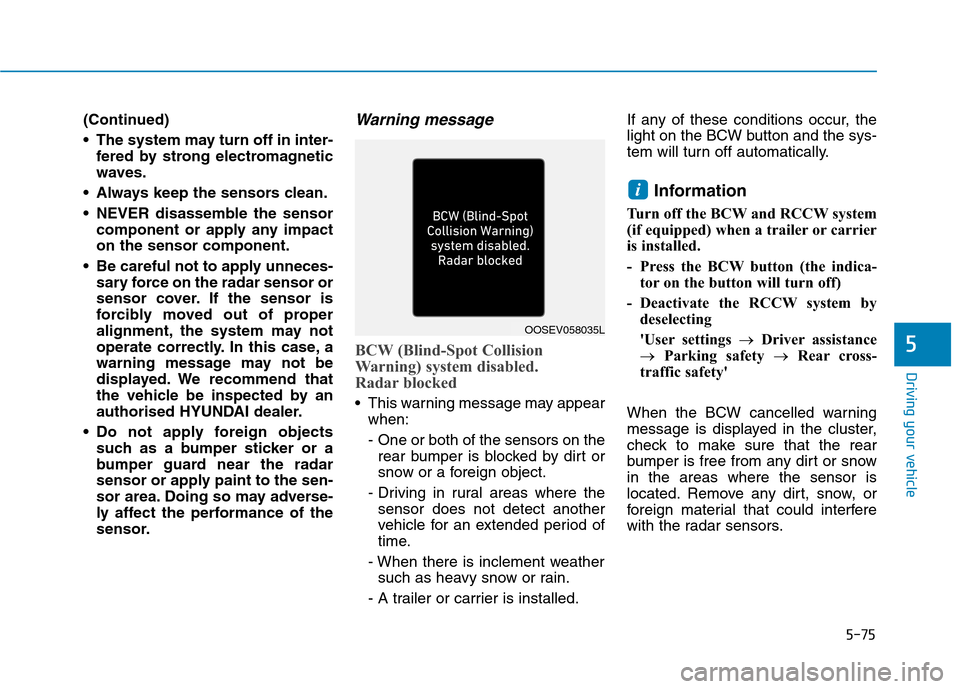
5-75
Driving your vehicle
5
(Continued)
The system may turn off in inter-
fered by strong electromagnetic
waves.
Always keep the sensors clean.
NEVER disassemble the sensor
component or apply any impact
on the sensor component.
Be careful not to apply unneces-
sary force on the radar sensor or
sensor cover. If the sensor is
forcibly moved out of proper
alignment, the system may not
operate correctly. In this case, a
warning message may not be
displayed. We recommend that
the vehicle be inspected by an
authorised HYUNDAI dealer.
Do not apply foreign objects
such as a bumper sticker or a
bumper guard near the radar
sensor or apply paint to the sen-
sor area. Doing so may adverse-
ly affect the performance of the
sensor.Warning message
BCW (Blind-Spot Collision
Warning) system disabled.
Radar blocked
This warning message may appear
when:
- One or both of the sensors on the
rear bumper is blocked by dirt or
snow or a foreign object.
- Driving in rural areas where the
sensor does not detect another
vehicle for an extended period of
time.
- When there is inclement weather
such as heavy snow or rain.
- A trailer or carrier is installed.If any of these conditions occur, the
light on the BCW button and the sys-
tem will turn off automatically.
Information
Turn off the BCW and RCCW system
(if equipped) when a trailer or carrier
is installed.
- Press the BCW button (the indica-
tor on the button will turn off)
- Deactivate the RCCW system by
deselecting
'User settings →Driver assistance
→ Parking safety →Rear cross-
traffic safety'
When the BCW cancelled warning
message is displayed in the cluster,
check to make sure that the rear
bumper is free from any dirt or snow
in the areas where the sensor is
located. Remove any dirt, snow, or
foreign material that could interfere
with the radar sensors.
i
OOSEV058035L
Page 390 of 613
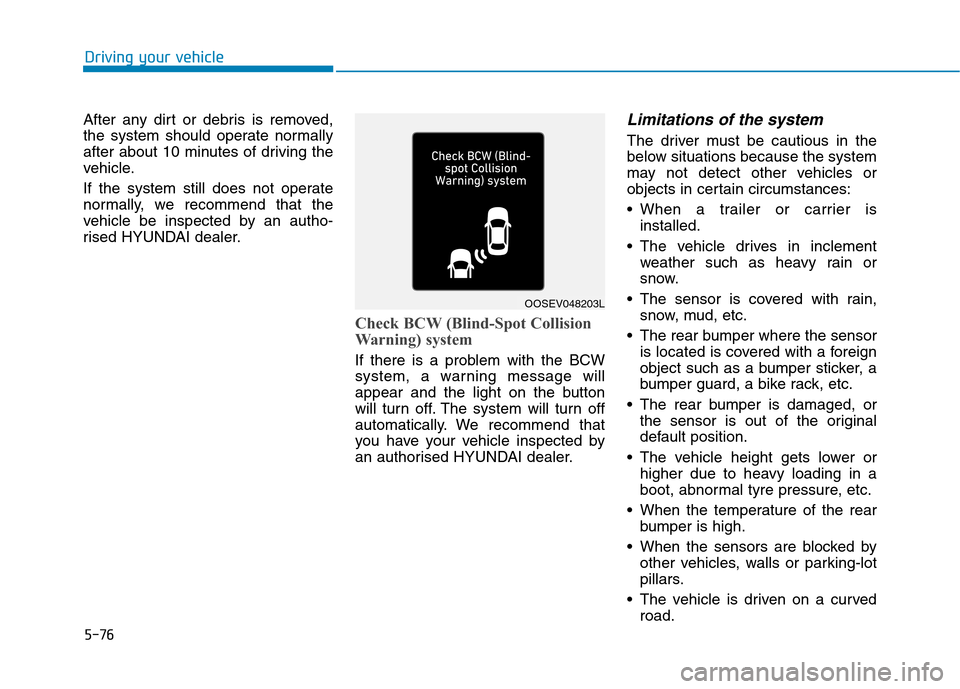
5-76
Driving your vehicle
After any dirt or debris is removed,
the system should operate normally
after about 10 minutes of driving the
vehicle.
If the system still does not operate
normally, we recommend that the
vehicle be inspected by an autho-
rised HYUNDAI dealer.
Check BCW (Blind-Spot Collision
Warning) system
If there is a problem with the BCW
system, a warning message will
appear and the light on the button
will turn off. The system will turn off
automatically. We recommend that
you have your vehicle inspected by
an authorised HYUNDAI dealer.
Limitations of the system
The driver must be cautious in the
below situations because the system
may not detect other vehicles or
objects in certain circumstances:
When a trailer or carrier is
installed.
The vehicle drives in inclement
weather such as heavy rain or
snow.
The sensor is covered with rain,
snow, mud, etc.
The rear bumper where the sensor
is located is covered with a foreign
object such as a bumper sticker, a
bumper guard, a bike rack, etc.
The rear bumper is damaged, or
the sensor is out of the original
default position.
The vehicle height gets lower or
higher due to heavy loading in a
boot, abnormal tyre pressure, etc.
When the temperature of the rear
bumper is high.
When the sensors are blocked by
other vehicles, walls or parking-lot
pillars.
The vehicle is driven on a curved
road.
OOSEV048203L
Page 391 of 613
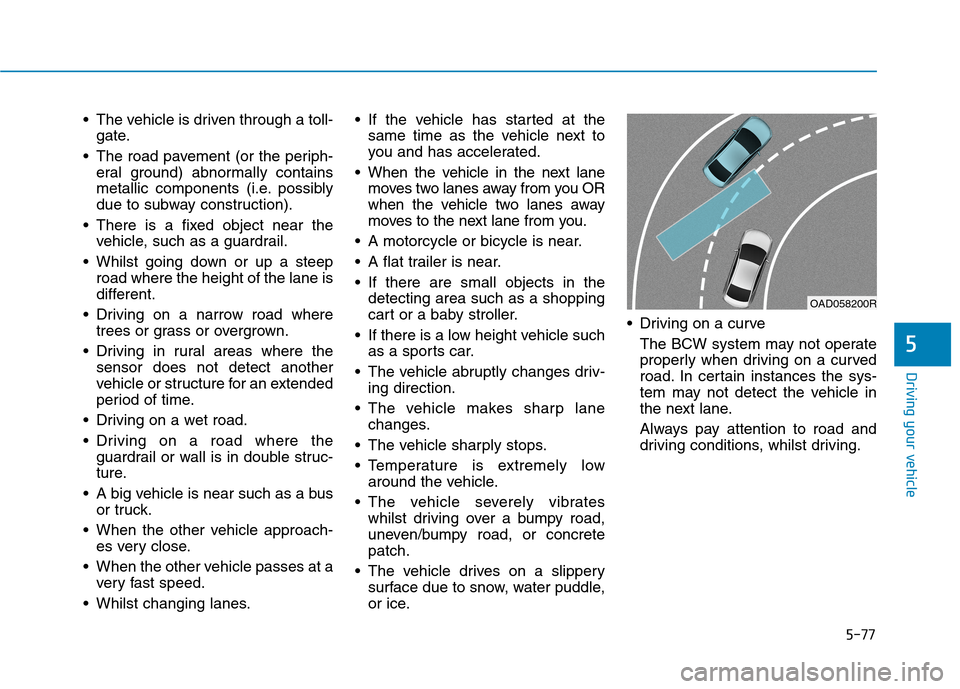
5-77
Driving your vehicle
5
The vehicle is driven through a toll-
gate.
The road pavement (or the periph-
eral ground) abnormally contains
metallic components (i.e. possibly
due to subway construction).
There is a fixed object near the
vehicle, such as a guardrail.
Whilst going down or up a steep
road where the height of the lane is
different.
Driving on a narrow road where
trees or grass or overgrown.
Driving in rural areas where the
sensor does not detect another
vehicle or structure for an extended
period of time.
Driving on a wet road.
Driving on a road where the
guardrail or wall is in double struc-
ture.
A big vehicle is near such as a bus
or truck.
When the other vehicle approach-
es very close.
When the other vehicle passes at a
very fast speed.
Whilst changing lanes. If the vehicle has started at the
same time as the vehicle next to
you and has accelerated.
When the vehicle in the next lane
moves two lanes away from you OR
when the vehicle two lanes away
moves to the next lane from you.
A motorcycle or bicycle is near.
A flat trailer is near.
If there are small objects in the
detecting area such as a shopping
cart or a baby stroller.
If there is a low height vehicle such
as a sports car.
The vehicle abruptly changes driv-
ing direction.
The vehicle makes sharp lane
changes.
The vehicle sharply stops.
Temperature is extremely low
around the vehicle.
The vehicle severely vibrates
whilst driving over a bumpy road,
uneven/bumpy road, or concrete
patch.
The vehicle drives on a slippery
surface due to snow, water puddle,
or ice. Driving on a curve
The BCW system may not operate
properly when driving on a curved
road. In certain instances the sys-
tem may not detect the vehicle in
the next lane.
Always pay attention to road and
driving conditions, whilst driving.
OAD058200R
Page 400 of 613
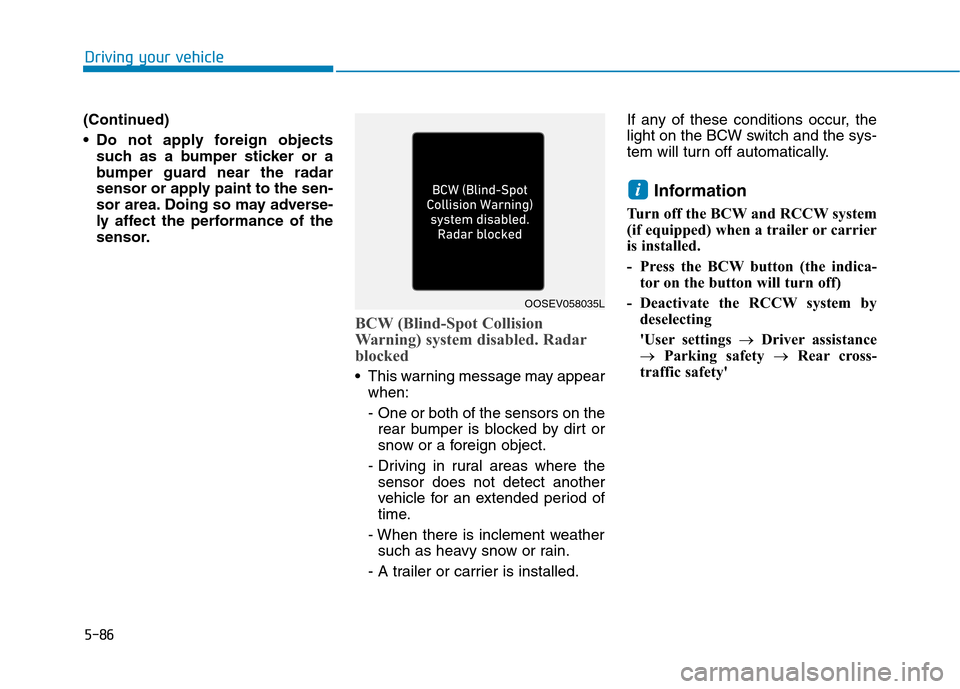
5-86
Driving your vehicle
(Continued)
Do not apply foreign objects
such as a bumper sticker or a
bumper guard near the radar
sensor or apply paint to the sen-
sor area. Doing so may adverse-
ly affect the performance of the
sensor.
BCW (Blind-Spot Collision
Warning) system disabled. Radar
blocked
This warning message may appear
when:
- One or both of the sensors on the
rear bumper is blocked by dirt or
snow or a foreign object.
- Driving in rural areas where the
sensor does not detect another
vehicle for an extended period of
time.
- When there is inclement weather
such as heavy snow or rain.
- A trailer or carrier is installed.If any of these conditions occur, the
light on the BCW switch and the sys-
tem will turn off automatically.
Information
Turn off the BCW and RCCW system
(if equipped) when a trailer or carrier
is installed.
- Press the BCW button (the indica-
tor on the button will turn off)
- Deactivate the RCCW system by
deselecting
'User settings →Driver assistance
→ Parking safety →Rear cross-
traffic safety'
i
OOSEV058035L
Page 401 of 613
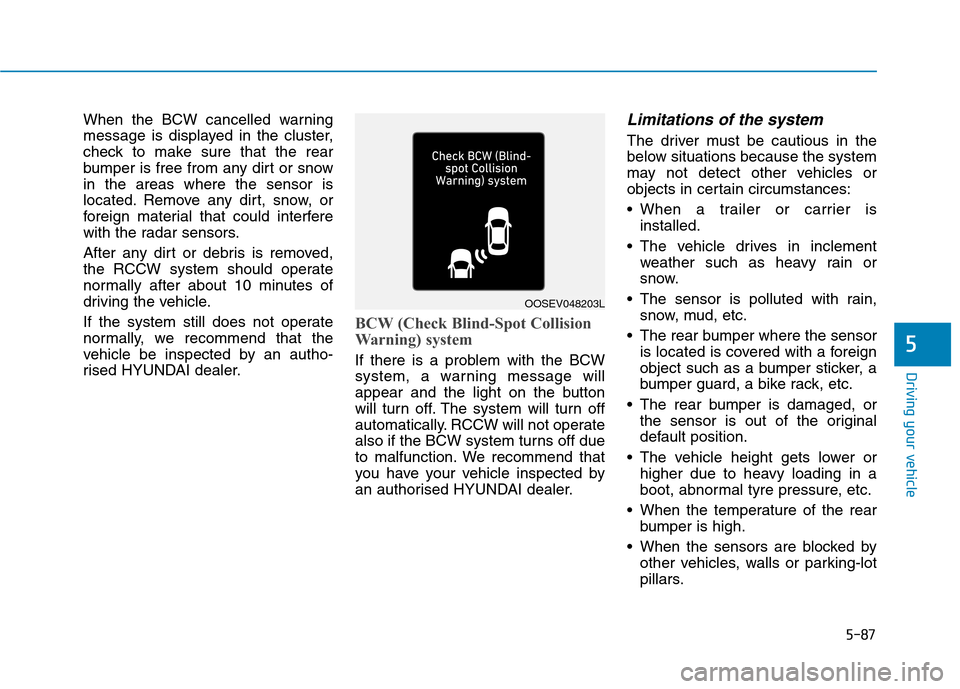
5-87
Driving your vehicle
5
When the BCW cancelled warning
message is displayed in the cluster,
check to make sure that the rear
bumper is free from any dirt or snow
in the areas where the sensor is
located. Remove any dirt, snow, or
foreign material that could interfere
with the radar sensors.
After any dirt or debris is removed,
the RCCW system should operate
normally after about 10 minutes of
driving the vehicle.
If the system still does not operate
normally, we recommend that the
vehicle be inspected by an autho-
rised HYUNDAI dealer.
BCW (Check Blind-Spot Collision
Warning) system
If there is a problem with the BCW
system, a warning message will
appear and the light on the button
will turn off. The system will turn off
automatically. RCCW will not operate
also if the BCW system turns off due
to malfunction. We recommend that
you have your vehicle inspected by
an authorised HYUNDAI dealer.
Limitations of the system
The driver must be cautious in the
below situations because the system
may not detect other vehicles or
objects in certain circumstances:
When a trailer or carrier is
installed.
The vehicle drives in inclement
weather such as heavy rain or
snow.
The sensor is polluted with rain,
snow, mud, etc.
The rear bumper where the sensor
is located is covered with a foreign
object such as a bumper sticker, a
bumper guard, a bike rack, etc.
The rear bumper is damaged, or
the sensor is out of the original
default position.
The vehicle height gets lower or
higher due to heavy loading in a
boot, abnormal tyre pressure, etc.
When the temperature of the rear
bumper is high.
When the sensors are blocked by
other vehicles, walls or parking-lot
pillars.
OOSEV048203L
Page 402 of 613
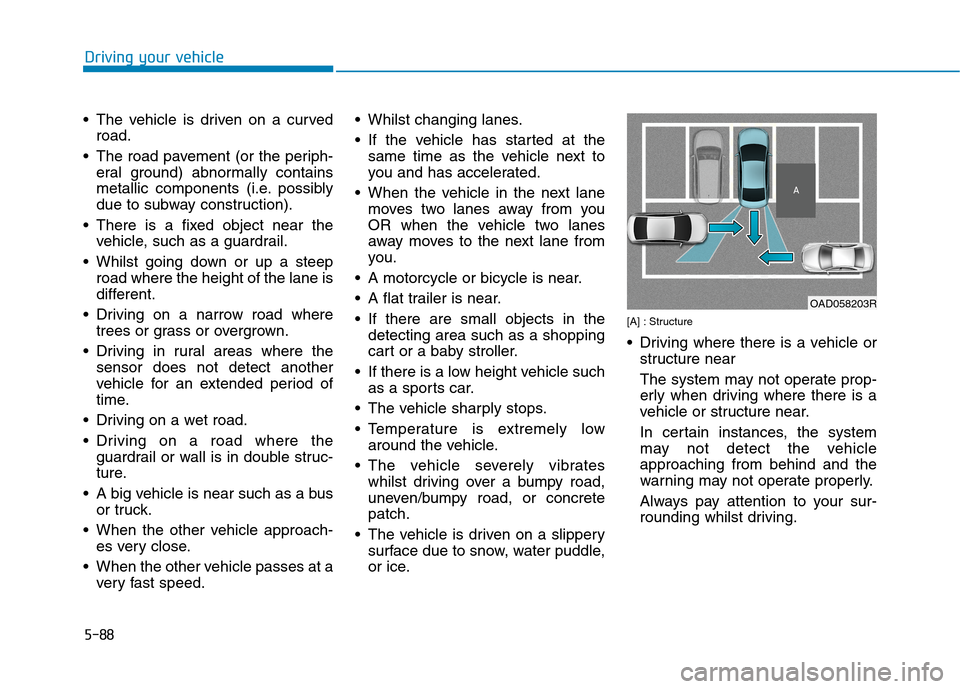
5-88
Driving your vehicle
The vehicle is driven on a curved
road.
The road pavement (or the periph-
eral ground) abnormally contains
metallic components (i.e. possibly
due to subway construction).
There is a fixed object near the
vehicle, such as a guardrail.
Whilst going down or up a steep
road where the height of the lane is
different.
Driving on a narrow road where
trees or grass or overgrown.
Driving in rural areas where the
sensor does not detect another
vehicle for an extended period of
time.
Driving on a wet road.
Driving on a road where the
guardrail or wall is in double struc-
ture.
A big vehicle is near such as a bus
or truck.
When the other vehicle approach-
es very close.
When the other vehicle passes at a
very fast speed. Whilst changing lanes.
If the vehicle has started at the
same time as the vehicle next to
you and has accelerated.
When the vehicle in the next lane
moves two lanes away from you
OR when the vehicle two lanes
away moves to the next lane from
you.
A motorcycle or bicycle is near.
A flat trailer is near.
If there are small objects in the
detecting area such as a shopping
cart or a baby stroller.
If there is a low height vehicle such
as a sports car.
The vehicle sharply stops.
Temperature is extremely low
around the vehicle.
The vehicle severely vibrates
whilst driving over a bumpy road,
uneven/bumpy road, or concrete
patch.
The vehicle is driven on a slippery
surface due to snow, water puddle,
or ice.
[A] : Structure
Driving where there is a vehicle or
structure near
The system may not operate prop-
erly when driving where there is a
vehicle or structure near.
In certain instances, the system
may not detect the vehicle
approaching from behind and the
warning may not operate properly.
Always pay attention to your sur-
rounding whilst driving.
OAD058203R